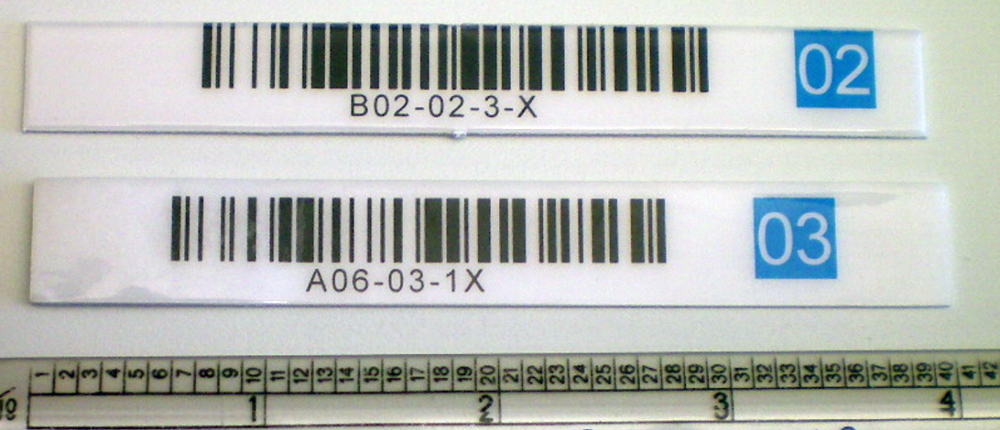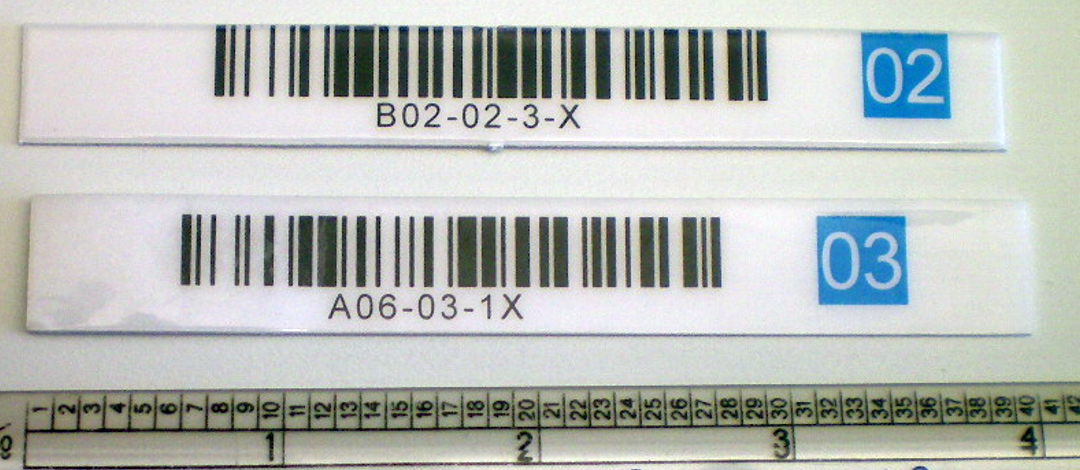Background: Identification of shelf location has been problematic.
The Gap’s distribution center covers one million square feet and provides clothing and other items for The Gap, Banana Republic and Old Navy retail stores. The clothier receives thousands of boxes daily, then sorts and ships garments to individual stores and outlets around the country. Miles of conveyors and three levels of shelving racks are present throughout the entire complex. They plan to increase shelving throughout the building.
Requirements: The Gap needed a tag product with the following requirements:
- A tag that would be sealed to protect the barcode image inside.
- A “thick” tag so it could be nailed or screwed to the particle board.
- Code 128 barcode number from an extensive excel spreadsheet
- An additional, reversed two-color block number that was associated with the unique barcode and the specific aisle.
- A quick and easy way to adhere the product.
Issue: Rack labels not adhering to particle board racks – no smooth surface.

Instead of traditional painted metal shelving, the Gap D/C uses particle board as the staging shelf for the different boxes of garments. Pickers are constantly pulling the boxes to fill orders using a tote conveyor system. One problem is that the standard rack labels have been unable to adhere well to the rough, porous edges of the shelving. In the past, the Gap has tried several solutions with little success:
- Aggressive adhesive – since the labels are printed using a barcode printer, the amount of adhesive on the labels is limited. The wood edge is small (.5”), so there is a minimal amount of surface onto which the label will be applied. Additionally, adhesive will only work with a smooth surface. Since particle board is rough and fibrous, labels may begin to peel away from the board in as little as two weeks.
- Larger label – in light of the small surface area, a second idea was to create a label that was placed over and under the board, so that there could be a larger surface for the adhesive to “grip.” The problem was that the boxes were moved over the surface several times – eventually peeling up the label, exposing the adhesive and adhering to the boxes.
- Polyurethane surface – another way to address the problem was to “brush on” a clear polyurethane coating to help affix the label to the shelf. This idea was rejected due to the amount of labor it would take to complete the job. There are over 58,000 tags to be placed, so placement time has to be considered.
Initial Proposed Solution:
Originally, the Gap had decided on a .5” x 4” clear plastic piece with two drill holes and a polyester label that would be placed on top of the plastic. Additionally, there was an adhesive strip on the back to help align the tag before screws were drilled into the holes. This was an expensive proposition (14 cents each for 58,000 label or $8,120) and was going to take an excessive amount of time to complete.
Idezi (Final) Solution:
Idezi developed a tag that was sequentially digitally printed (two-color, unique barcode for each tag), laminated with 20 mil coating and presented to the Gap in large sheets with die cuts of the tags (.5” x 4”) so that the employees would be able to “snap” the tags out of the sheet for fast and easy placement. Since the tags were provided in 14” x 11” sheets rather than individual .5” x 4” tags, it made it much easier to locate the specific tag. The tags were printed “in order,” so the employee could quickly snap out the tag one shelf after another.
Instead of using drills and small screws, Idezi suggested a $20 heavy-duty staple gun which uses small finishing nails. This provides easy placement by stapling a finishing nail into the particle board. There is no need to align the screw or deal with extension cords, batteries, etc. This unique approach saved an estimated 160 man hours for the Gap employees. Since there were over 58,000 tags, the application process was a critical component of the Idezi solution.

Conclusion:
By understanding and adapting the process, Idezi was able to save The Gap over $2,320 in the tags alone. Reducing labor 160 hours at $10 per hour adds another $1,600 in savings.
If you have a unique rack label or identification need for your warehouse, contact Idezi. We do more than provide a competitive price. We evaluate the situation, determine the best way to solve the problem and provide an efficient, permanent solution. To learn more, call 615-377-8849 to discuss your Rack Label needs.

Recent Comments